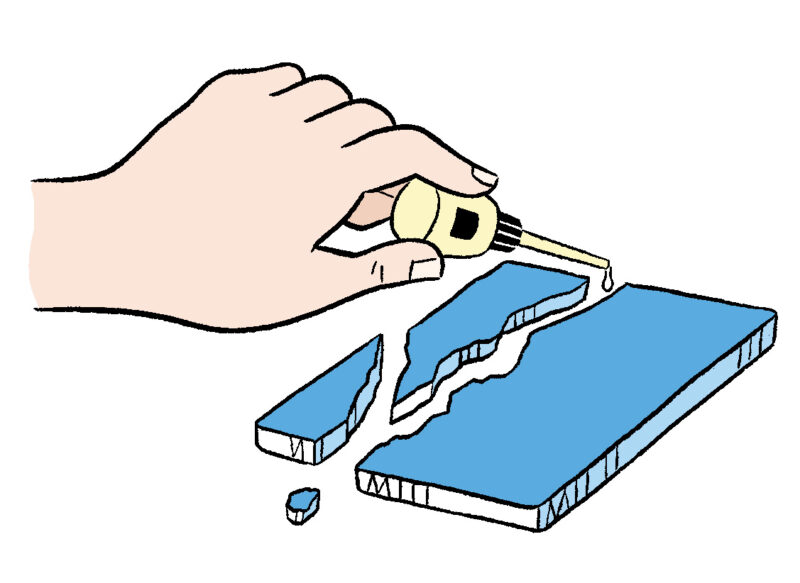FEATURES:
- Multicolored
- Purchased at the art store in town
- Healing
I live in a mansion. It has a black-and-white tiled kitchen floor. When I moved in, some tiles had broken edges, leaving irregular divots. I filled them in with tinted glass—green, yellow, orange, blue, white. The colors pop against the black-and-white boundaries, yelling out light.
It isn’t mine, the mansion. I’m the resident faculty adviser for an off-campus house that my college owns. It was built in the 1880s; the college bought it in 1960. About twenty students live here on the second and third floors. My apartment is on one side of the first floor.
I’ve been upstairs only a few times. The first time was about a month after I moved in. That was after the separation. The prior adviser unexpectedly moved out, leaving the space in want of new occupation. Being broken left me in want of new occupation.
The first time I went upstairs was during a storm, because the power was out. The students were playing cards by iPhone-light. They asked me to join them. I was up there a second time after everyone moved out in the summer, and a friend and I were mutually curious about what the place looked like. It looked really nice, with nooks, small alcoves, study spots, side rooms. It blows my mind that this Victorian Gothic masterpiece is essentially a dorm.
Back in my apartment, the kitchen floor staring at me was less majestic. It reflected back the fractures of a twenty-six-year marriage’s end. It was hard to think about; it’s hard to talk about. The cracks in the tiles didn’t help.
It’s somewhat obvious that the apartment was the servants’ quarters a hundred years ago. The butler’s pantry gives it away. It’s about ten by twelve feet, ringed by ten glass-doored cabinets, each with four shelves. I’m currently using three and a half of the forty shelves.
The kitchen is fifteen by fifteen feet, with a mid-century ceramic sink basin in one corner, a stove in another, and the fridge in a third. On the wall beside the fridge is an old doorbell in a glass case with two pointers, an artifact from the servants’ past: one points to front door, the other to auto entrance.
The tiles on the floor are distressed, worn and soft. They look like faux limestone, or vinyl marble. I’d date them to the 1950s, like the sink.
There were a few broken tile corners and edges, leaving some gaps and spaces.
I got it in mind to find stained glass, or pieces of glass, or broken colored tiles. I went to an art store in town and asked, “Do you have broken tiles or mosaic pieces or pieces of glass or I’m not sure what? Something colored and various?” A horn-rimmed-glasses clerk stared me down. “No, no, we wouldn’t have anything like that.” Then he walked back a few aisles to show me something he thought might be close, which was a container of 100 percent exactly what I had been looking for. Either I’m a terrible describer or he was a terrible listener or we maybe met in the middle.
I have a faint memory of seeing an article about mending cracks with misshapen mosaic tiles. Guerrilla street artists used potholes and damaged sidewalks as open canvases to be filled in. They replaced something empty and faded with something living and recovered. I came home and dumped out the small box of broken colored pieces of glass onto the floor, sat down on my knees, and arranged them in the empty spaces. I glued each underside with a silicone epoxy I got at Ace Hardware.
The first space I worked on was the entry to the kitchen. It is a random assortment of different colors. For the next, on the other side, I tried to make it look like a landscape, like a cloud hovering over green reeds and blue water. Except I spaced out, and the clouds (white glass) are in the middle. Which looks just as good.
I needed repair. It’s been exhausting, with so much broken. The colors contrast haphazardly with the black and white. Small healing shocks of color stand out against dull chromatic squares. Recovery is a kind of improvement; repair is a kind of solace.





